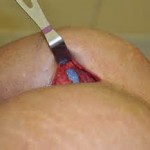While implants are used all over the body from the breasts to the calfs very successfully, their use for buttock augmentation is associated with a more checkered experience. Not that implants anywhere can’t be associated with complications, but buttock implants carry a disproportionate amount of criticism. This is partially due to the availability of fat grafting as a buttock augmentation method that doesn’t carry those same risks. It is also because the buttocks are associated with a unique set of recovery issues.

Buttock implants can be placed either above the muscle (subfascial) or into the muscle. (intramuscular) While surgeons can place them in either tissue plane, the subfascial location is technically easier to do, has an easier patient recovery and permits implants of almost any size to be placed. However, it is associated with a much higher rate of complications including seroma, infection, implant show, encapsulation and buttock deformity. While the intramuscular location is more technically demanding, has a longer recovery and allows only smaller implants to be placed, it results in a much lower number of complications. With rarer exceptions, buttock implants should be placed in the intramuscular location.

Between the intramuscular location and the size of the implants, patients opting for buttock implants must have realistic expectations. They will not get large or massively sized buttocks and the volume obtained is going to be in the upper half of the buttocks. This makes the best candidates for buttock implants as thin or lean women who do not have enough fat for the Brazilian Butt Lift option and can accept a modest increase in buttock size.
If properly done in the right patient, buttock implants can have very similar and success rates as that of the breast implants.
Dr. Barry Eppley
Indianapolis, Indiana


